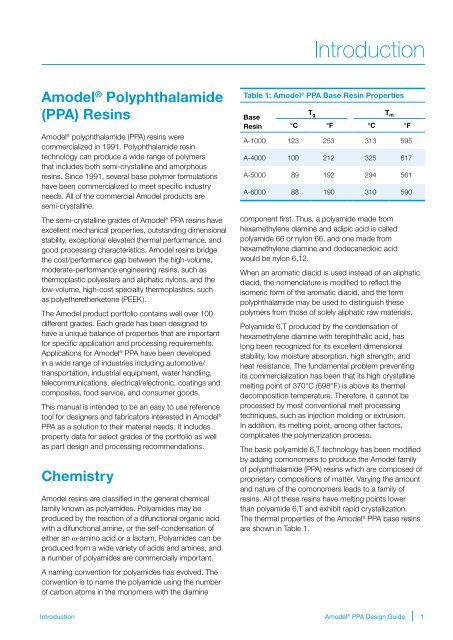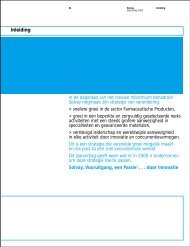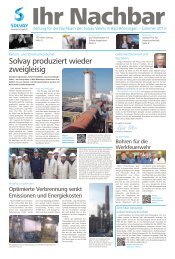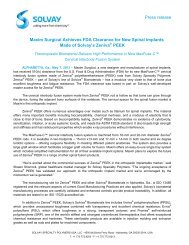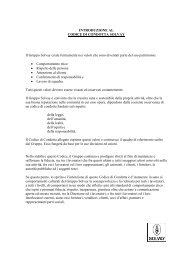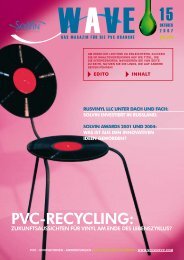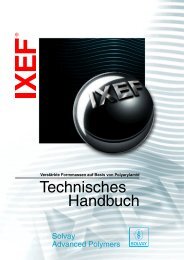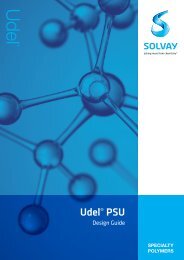Design Guide - Solvay Plastics
Design Guide - Solvay Plastics
Design Guide - Solvay Plastics
Create successful ePaper yourself
Turn your PDF publications into a flip-book with our unique Google optimized e-Paper software.
Introduction<br />
Amodel ® Polyphthalamide<br />
(PPA) Resins<br />
Amodel ® polyphthalamide (PPA) resins were<br />
commercialized in 1991. Polyphthalamide resin<br />
technology can produce a wide range of polymers<br />
that includes both semi-crystalline and amorphous<br />
resins. Since 1991, several base polymer formulations<br />
have been commercialized to meet specific industry<br />
needs. All of the commercial Amodel products are<br />
semi-crystalline.<br />
The semi-crystalline grades of Amodel ® PPA resins have<br />
excellent mechanical properties, outstanding dimensional<br />
stability, exceptional elevated thermal performance, and<br />
good processing characteristics. Amodel resins bridge<br />
the cost/performance gap between the high-volume,<br />
moderate-performance engineering resins, such as<br />
thermoplastic polyesters and aliphatic nylons, and the<br />
low-volume, high-cost specialty thermoplastics, such<br />
as polyetheretherketone (PEEK).<br />
The Amodel product portfolio contains well over 100<br />
different grades. Each grade has been designed to<br />
have a unique balance of properties that are important<br />
for specific application and processing requirements.<br />
Applications for Amodel ® PPA have been developed<br />
in a wide range of industries including automotive/<br />
transportation, industrial equipment, water handling,<br />
telecommunications, electrical/electronic, coatings and<br />
composites, food service, and consumer goods.<br />
This manual is intended to be an easy to use reference<br />
tool for designers and fabricators interested in Amodel ®<br />
PPA as a solution to their material needs. It includes<br />
property data for select grades of the portfolio as well<br />
as part design and processing recommendations.<br />
Chemistry<br />
Amodel resins are classified in the general chemical<br />
family known as polyamides. Polyamides may be<br />
produced by the reaction of a difunctional organic acid<br />
with a difunctional amine, or the self-condensation of<br />
either an ω-amino acid or a lactam. Polyamides can be<br />
produced from a wide variety of acids and amines, and<br />
a number of polyamides are commercially important.<br />
A naming convention for polyamides has evolved. The<br />
convention is to name the polyamide using the number<br />
of carbon atoms in the monomers with the diamine<br />
Table 1: Amodel ® PPA Base Resin Properties<br />
Base<br />
Resin<br />
T g<br />
T m<br />
°C °F °C °F<br />
A-1000 123 253 313 595<br />
A-4000 100 212 325 617<br />
A-5000 89 192 294 561<br />
A-6000 88 190 310 590<br />
component first. Thus, a polyamide made from<br />
hexamethylene diamine and adipic acid is called<br />
polyamide 66 or nylon 66, and one made from<br />
hexamethylene diamine and dodecanedioic acid<br />
would be nylon 6,12.<br />
When an aromatic diacid is used instead of an aliphatic<br />
diacid, the nomenclature is modified to reflect the<br />
isomeric form of the aromatic diacid, and the term<br />
polyphthalamide may be used to distinguish these<br />
polymers from those of solely aliphatic raw materials.<br />
Polyamide 6,T produced by the condensation of<br />
hexamethylene diamine with terephthalic acid, has<br />
long been recognized for its excellent dimensional<br />
stability, low moisture absorption, high strength, and<br />
heat resistance. The fundamental problem preventing<br />
its commercialization has been that its high crystalline<br />
melting point of 370°C (698°F) is above its thermal<br />
decomposition temperature. Therefore, it cannot be<br />
processed by most conventional melt processing<br />
techniques, such as injection molding or extrusion.<br />
In addition, its melting point, among other factors,<br />
complicates the polymerization process.<br />
The basic polyamide 6,T technology has been modified<br />
by adding comonomers to produce the Amodel family<br />
of polyphthalamide (PPA) resins which are composed of<br />
proprietary compositions of matter. Varying the amount<br />
and nature of the comonomers leads to a family of<br />
resins. All of these resins have melting points lower<br />
than polyamide 6,T and exhibit rapid crystallization.<br />
The thermal properties of the Amodel ® PPA base resins<br />
are shown in Table 1.<br />
Introduction<br />
Amodel ® PPA <strong>Design</strong> <strong>Guide</strong><br />
1


